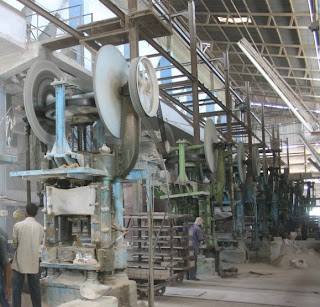What makes a refractory product sell? The factors determining the sales success are many and varied. They include market conditions, the nature of the product, and the image of the manufacturing organization in the market as well as of the product created by advertising, the socio-cultural background of customers, credit facilities, Customer Delight and so on.
But one major factor that appears certainly in all conditions (excluding monopoly or extreme scarcity) is product quality as perceived by the customer. The Production Department must accept its fundamental responsibility for the manufactured quality of its refractory products. The workforce with effective training and adequate equipment must be capable of -
1. consistently producing to specification and
2. recognizing and reacting when an operation goes out of control.
Adequate systems must be established to ensure that corrective action is taken. The quality control for Refractory Bricks refers to the following aspects:
=> Manufacturing defects.
=> Dimensional tolerances.=> Physical & Chemical material properties.
=> Quantities, Marking, Labelling and Packing.
While Sampling for visual and dimensional inspection, iron spot (crater) is always an important criteria of inspection. It is not an uncommon site or if one had a chance of visiting brick yards of a few Refractory manufacturing units then he must have noticed that in many such plants refractory bricks worth crores (millions) or thousands of tons are lying rejected because of developed iron spots (grey fusion spots) in them.
Before going into the steps as how to control the formation of these iron spots or iron craters in Refractory Bricks let us discuss a few more things in detail.
Iron Craters or similar Black Spots are actually melt phenomena, caused by mainly iron oxide or lime or some other low temperature fusion and melting elements mostly, alkalies. An Iron spot on the surface of a refractory brick can be tested with a hammer (I assume Refractory persons would be acquainted with this tool :-) ) to determine the possible presence of crater which can be dangerous for the brick and so, for the furnace after lining. Some common reasons/sources of these iron spots and preventive actions required to be taken regularly to stop formation of such black spots and maintain the quality of refractory bricks are outlined below:
Refractory Raw Materials
Preventive Measure: Checking the Raw Material & removing free iron from it before grinding / using. Sorting of Slag / Iron patch especially in calcined fire clay and other calcined raw materials at the kiln yard itself.
Responsibility: Mill house, Calcination Kiln, Checking & RM yard.
Own Rejection (Refractory Grog)
Preventive Measure: Iron containing (contaminated) grog to be kept in strict isolation.
Responsibility: Checking & RM yard.
Outside Grog
Preventive Measure: Visual inspection in the Truck itself by breaking up the lumps into pieces before taking into the raw material yard. Briquette test in the Laboratory.
Responsibility: Checking & RM yard. Laboratory (Quality Assurance).
Maintenance Waste
Preventive Measure: Proper cleaning of waste & scraps after Maintenance of any machine in the shop-floor e.g. iron chips, welding tips etc. before handover to the Production Deptt (there should be a proper Handover – Takeover system). Cleaning before & after maintenance of each machine (Mill House, Mixer, Press etc).
Responsibility: Concerned person of the Maintenance Deptt. Shift in charge of the concerned area (Mill House, Press, and Production).
Free iron in Mill House Silo Material
Actions Required: Due to Beater => regular cleaning of Magnetic drum, Plate & Roller Magnets. Due to Rusted plates => Silo cleaning once in a fortnight.
Responsibility: Mill House. Maintenance. Production departments.
Free iron from Press Hoppers / Mill Hoppers
Actions Required: Due to Rusted plates => Hopper cleaning once in a fortnight.
Responsibility: Production.
These are the certain necessary steps which, if taken properly, can arrest the formation of grey craters and iron spots which become visible on the surface of refractory bricks only after the firing is over that means everything is over!










